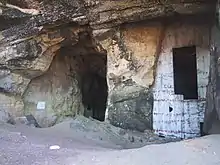Sculptor's Cave
The Sculptor's Cave is a sandstone cave on the south shore of the Moray Firth in Scotland, near the small settlement of Covesea, between Burghead and Lossiemouth in Moray.[1] It is named after the Pictish carvings incised on the walls of the cave near its entrances.[2] There are seven groups of carvings dating from the 6th or 7th century, including fish, crescent and V-rod, pentacle, triple oval, step, rectangle, disc and rectangle, flower, and mirror patterns,[3] some very basic but others more sophisticated.[4]

The cave is 20m deep and 13.5m wide with a 5.5m high roof and can be entered by two parallel 11m long passages, each 2-3m wide.[5] It lies at the base of 30m high cliffs and is largely inaccessible at high tide.[6]
The cave was first excavated between 1928 and 1930 by Sylvia Benton, who discovered evidence of two main periods of activity on the site: the first during the late Bronze Age, and the second during the late Roman Iron Age, between the 2nd and 4th centuries AD.[6]
Notes
- "Sculptor's Cave, Covesea". Canmore. Historic Environment Scotland. Retrieved 2020-08-31.
- "SCULPTORS' CAVE, COVESEA". Moray Historic Environment Record. Aberdeenishire Council. Retrieved 2020-08-31.
- "Covesea Description of stone". Canmore. Historic Environment Scotland. Retrieved 2020-08-31.
- Shepherd 1993, p. 81.
- Armit et al. 2011, p. 254.
- Armit et al. 2011, p. 251.
References
- Armit, Ian; Schulting, Rick; Knüsel, Christopher J.; Shepherd, Ian A.G. (2011). "Death, Decapitation and Display? The Bronze and Iron Age Human Remains from the Sculptor's Cave, Covesea, North-east Scotland". Proceedings of the Prehistoric Society. 77: 251–278. doi:10.1017/S0079497X00000694. Retrieved 2020-08-31.
- Shepherd, Ian A. G. (1993). "The Picts in Moray". In Sellar, W. David H. (ed.). Moray: Province and People. Scottish Society for Northern Studies. pp. 75–90. ISBN 0950599476.